Fatsia Japonicas are beautiful tropical looking plants that have large glossy evergreen leaves.
They can be grown as houseplants or outside in the garden, and can become very large bushes.
Factors can affect their health and appearance however, causing the plant to droop and suffer.
In this article we identify these factors and find out how to resolve them, answering the question “Why Is My Fatsia Japonica Drooping?”
2. Incorrect Position in the Garden
3. Cold Weather or Snow
4. The Plant Needs Pruning
5. The Plant has Outgrown it’s Pot
6. Leaf Spot Disease – Anthracnose
Watering – Too Much, Too Little or Inconsistent
Although they look as if they come from the rain forest, Fatsia Japonica‘s natural habitat is the cool woodlands of Asia.
Here the temperatures are similar to the UK, however the humidity is higher.
For this reason Fatsia Japonicas will not thrive in very dry conditions, but they do not like to sit in water either.
If your climate is humid with regular rainfall then Fatsia Japonicas planted outside will not need additional watering.
Overwatering will cause the roots to rot and the leaves to turn yellow and wilt.
If your climate is very dry then it is recommended to water your Fatsia Japonica well about once a week.
Underwatering or inconsistent watering will cause the leaves to dry out, turn brown and fall.
How to fix:
- Feel the soil under your Fatsia Japonica with your hand. If the top 5-10cm is dry then water, but don’t soak.
- Make sure the water is sinking in and not pooling around the base or running off.
- Consider your soil type. Fatsia Japonicas require well draining slightly acidic soil with some enrichment, so add grit or compost to adjust your soil to suit.
Incorrect Position in the Garden
As mentioned above, Fatsia Japonicas are woodland plants and will not like full sun or exposed conditions.
Too much sun can cause the glossy leaves to become scorched and crinkle.
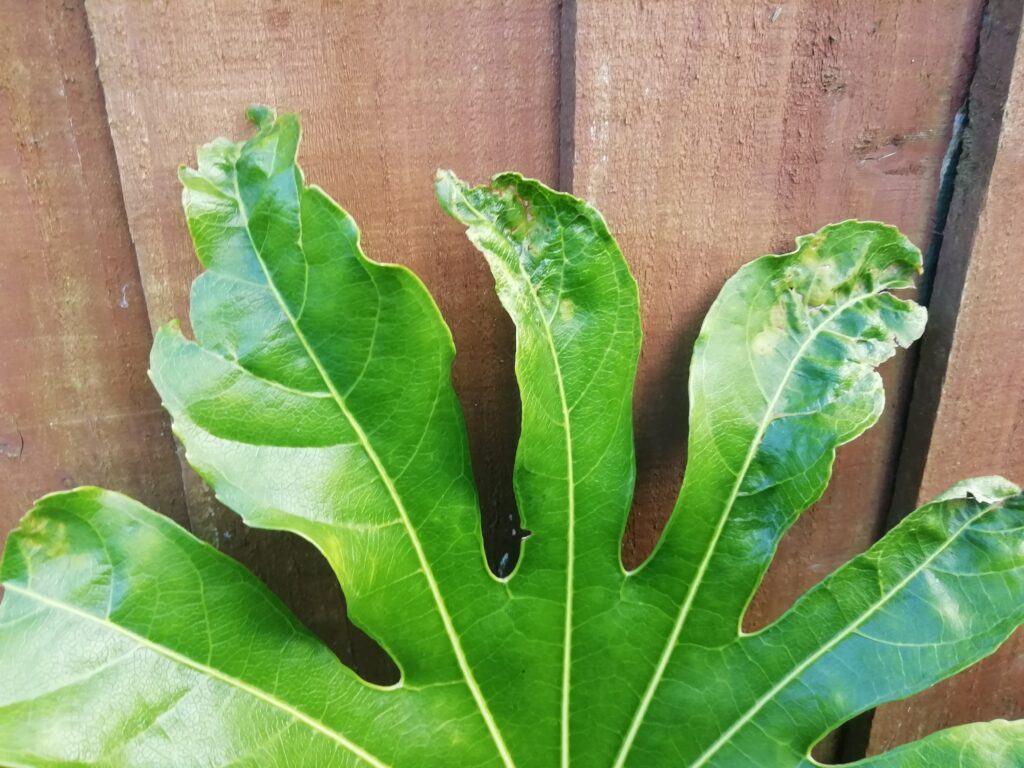
Although they are reasonable hardy, an exposed windy position will cause the large leaves to whip about, possibly ripping or even detaching altogether.
How to fix:
- Plant Fatsia Japonica in a fairly shady position, where it will receive no more than two hours of sunshine.
- Preferably position next to a fence, wall or tree to protect and shelter from winds.
- If you find that your Fatsia Japonica plant is struggling where it is then it is possible to move it.
- Ideally move plants during early spring, before flowers have formed as the plant expends a lot of energy when flowering and will be less resilient.
- Move plants on a cool day, early in the morning when they will have their maximum water content.
- Make sure to include as much of the roots as possible and some of the surrounding soil to minimise transference stress.
- Water in well and monitor. Water again if necessary until established.
- You can also take cuttings of Fatsia Japonica by carefully snipping out a growing crown section and two strong leaves, wrapping the base in moist moss and leaving in a jar to root. You could then plant the new Fatsia Japonica in a better position.
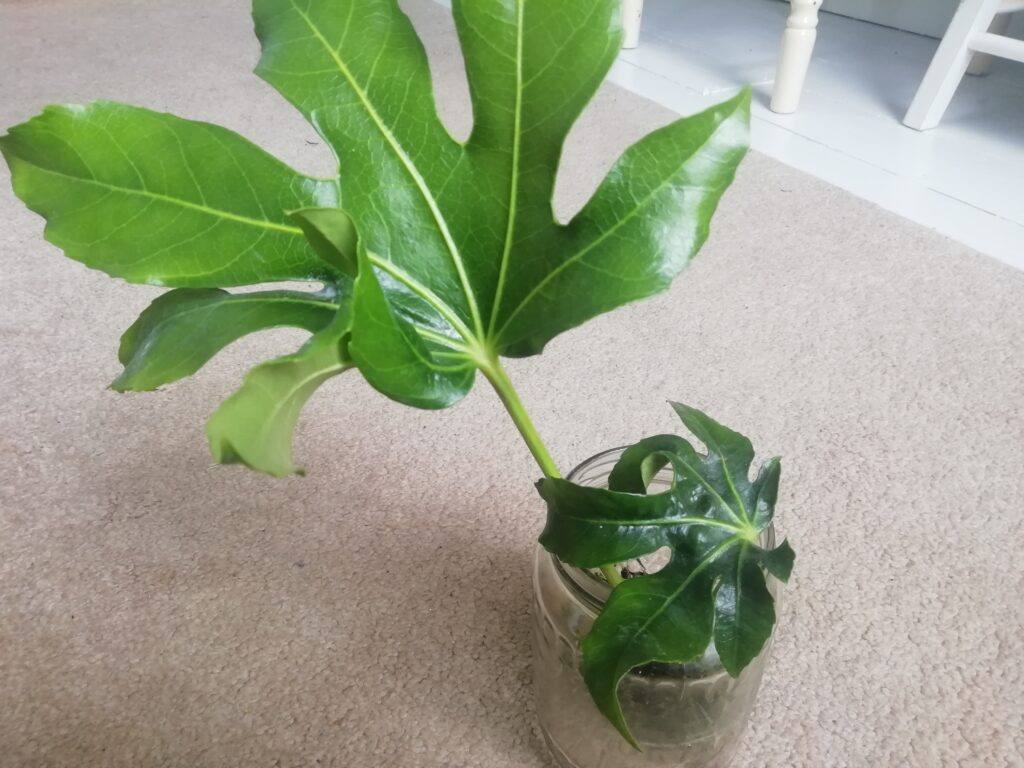
Cold Weather or Snow
Fatsia Japonica’s natural habitat can be subject to cold temperatures, even below freezing.
Because they are woodland plants however, they are largely protected from frost, heavy snowfall or icy winds.
In a garden that has experienced very wintry conditions, the Fatsia Japonica can be affected by frost or accumulated snow that damages the leaves and weighs the branches down.
Cold winds can lash the leaves around, damaging their glossy surface as well as the stems.
How to fix:
- Before the winter add a layer of mulch around the base of the Fatsia Japonica to protect the base through the cold season.
- In the case of very cold weather, check on your plant regularly and clear any accumulated snow or ice from the leaves, crown or around the base.
- If the plant is in an exposed condition and the cold snap looks set to continue, consider wrapping your Fatsia Japonica in fleece to protect it.
- If your plant does suffer frost or snow damage then once the cold weather has passed you can prune the affected leaves or stems.
- Do not remove more than one third of the foliage however as the Fatsia Japonica will not recover.
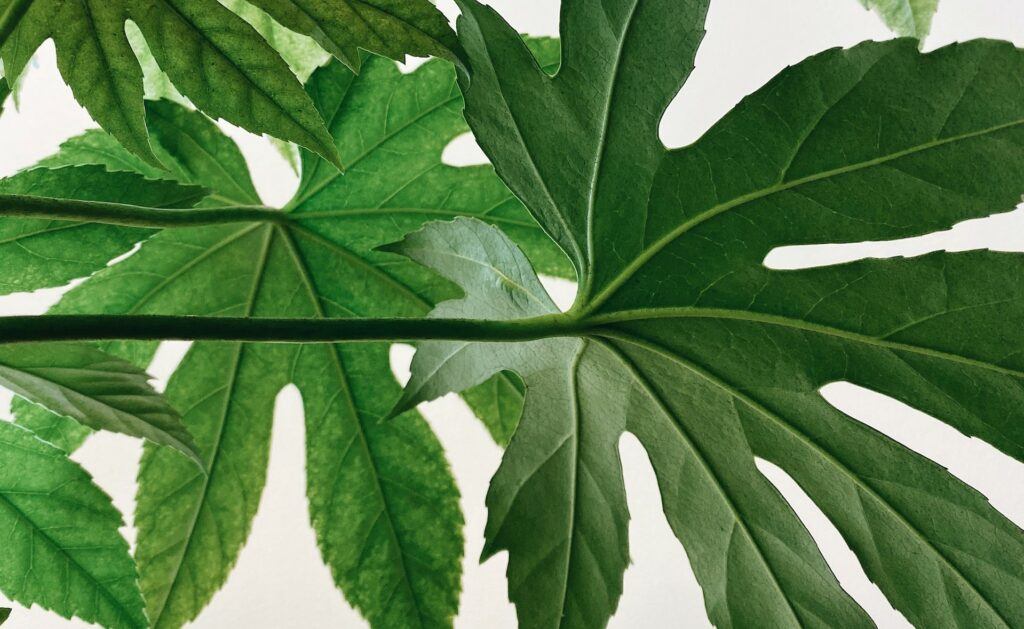
The Plant Needs Pruning
Fatsia Japonicas can grow quite fast once they are established.
Sometimes this fast growth can result in a top-heavy plant that leans over and looks unattractive.
Ideally a bushy plant with lots of horizontal growth is desired, rather than tall vertical growth.
How to Fix:
- Prune in early spring once the last frost has passed.
- Using clean sterilized sharp shears, cut the top of the stem back to the desired height.
- Make sure to cut just above a strong horizontal branch node.
- This will encourage lateral growth.
- Remove any unhealthy stems and leaves but do not remove any more than one third of the foliage.
- The oldest bottom leaves will naturally turn brown and die back and these should be cleared regularly to maintain airflow around the base and stem.
- Also check the central stem for any weeds or creepers that may be encroaching.
- Then leave the plant to recover and start to regrow into a better shape.
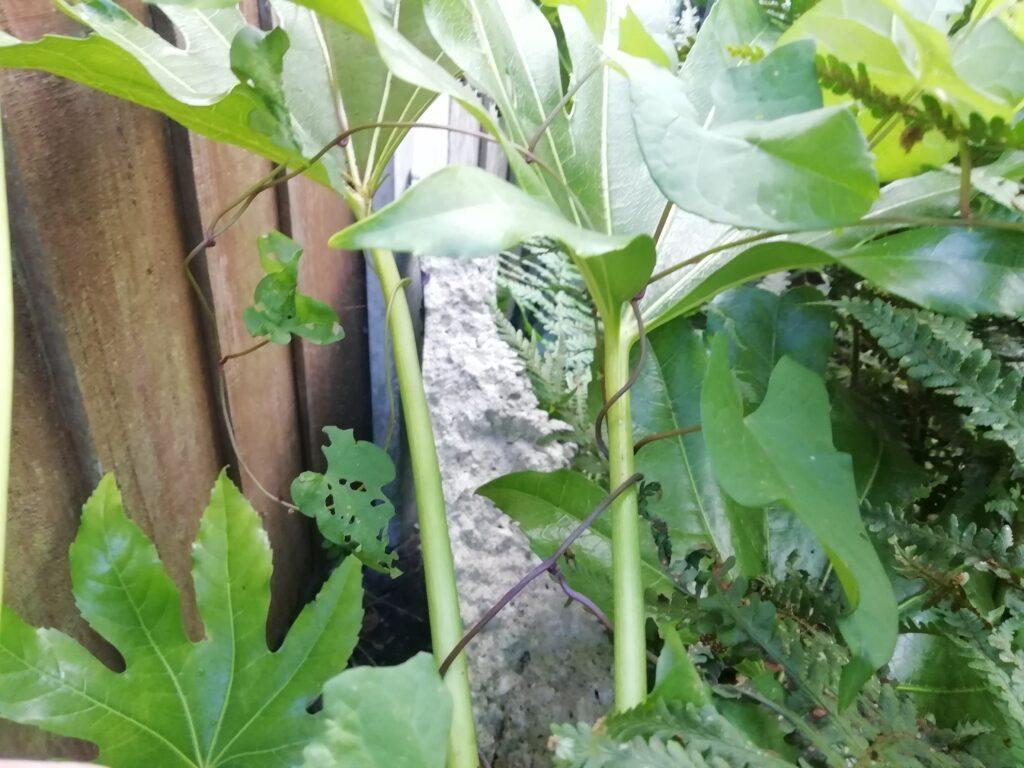
The Plant Has Outgrown it’s Pot
I mentioned above that Fatsia Japonica is often grown as a houseplant, and in fact that is how I purchased mine.
It did alright for a while but then started to look unhealthy and droop.
I planted it outside and it although it took a year or so to establish it is now growing very well.
How to fix:
- If you have a potted Fatsia Japonica that is looking unwell, take it out of the pot and check the roots.
- If the roots have wound around the pot then the plant has likely outgrown the pot.
- You can move it to a larger pot however if your climate is fairly cool and wet, the plant will probably do much better outside.
- Review the information above and chose a sheltered shady spot in the garden.
- Your Fatsia Japonica can then grow to be quite large.
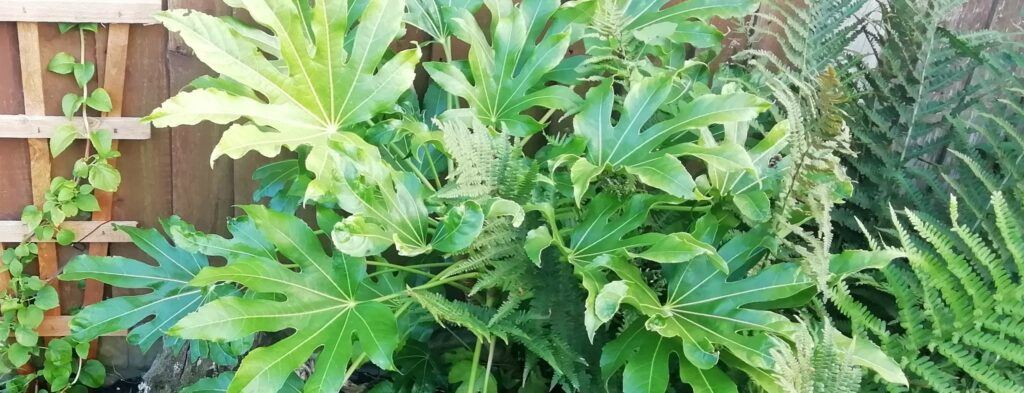
Leaf Spot Disease – Anthracnose
There have been increasing reports of Fatsia Japonica suffering from Leaf Spot Disease “Anthracnose” which is a fungal disease affecting plants that live in shady conditions.
Spores can be transmitted by rain and wind.
The infection starts as small brown or yellow spots on older leaves, these spots then grow and darken.
The leaves then wither and fall.
This is not usually fatal to the plant and can be resolved with correct management.
How to fix:
- Regularly monitor your Fatsia Japonica and if you see any sign of spores, spots or discoloration on leaves or stems, act quickly and remove the affected parts.
- Dispose of any affected material (not in the compost heap).
- Improve the ventilation and airflow surrounding your plant by regularly clearing the base and stem of decomposing debris.
- Water gently at the base rather than from overhead to minimise splashing and transferring spores.
- Mulch at the base to from a barrier between fallen plant matter containing possible spores.
Final Thoughts
Fatsia Japonica is a very attractive addition to the garden.
The large glossy evergreen leaves give a tropical look, and the plant is surprisingly hardy in the correct growing conditions so they are perfect for beginner gardeners.
Here we have covered the main reasons that may cause your Fatsia Japonica to struggle and droop, and how to fix them.
If you have experienced any other issues with your Fatsia Japonica please drop a comment below and I will do my best to help.

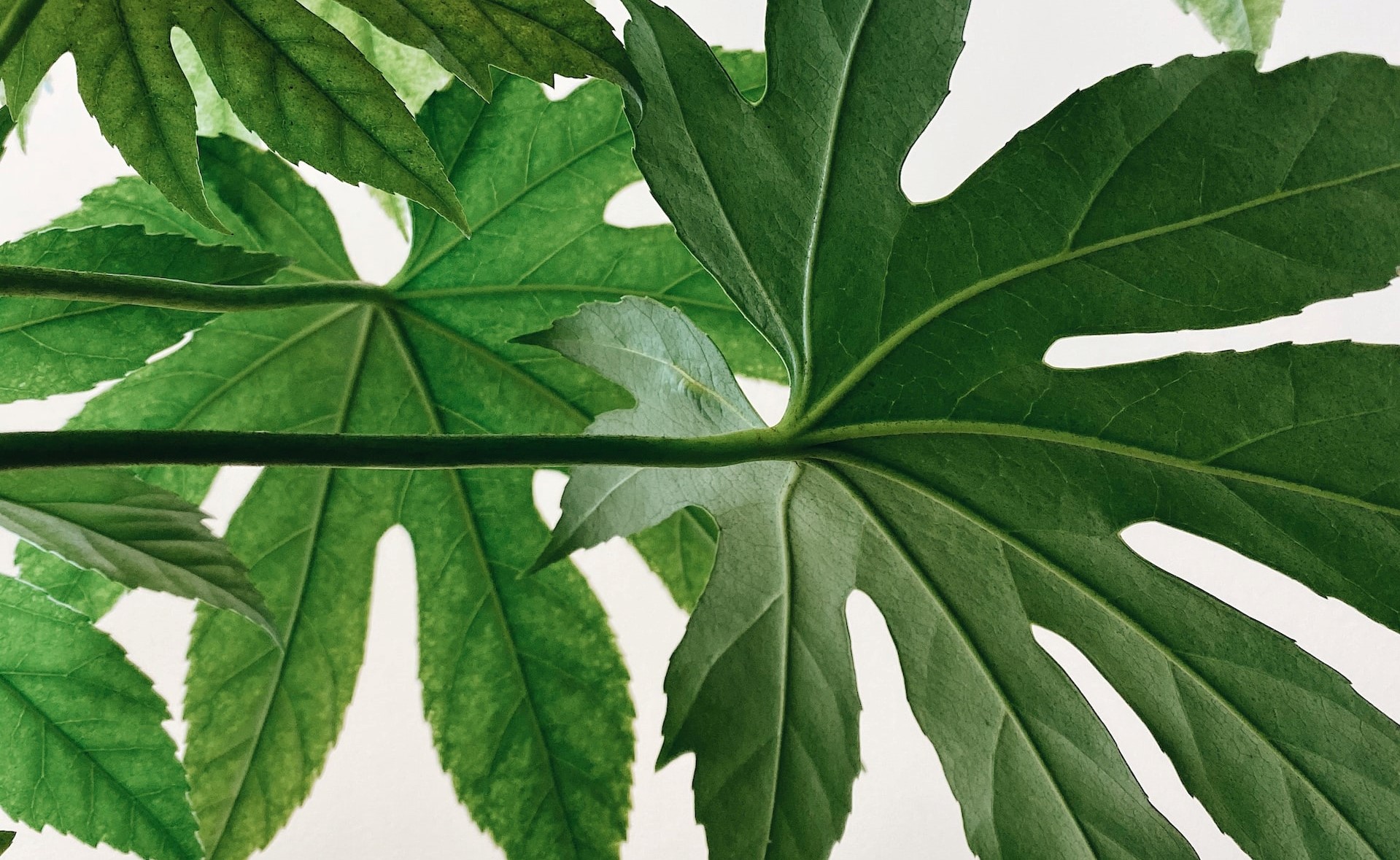
Mines is inside dropping
Please help love my Fatsia Japonica
Dear Jacqueline,
I’m sorry to hear that, they are fabulous plants – lets try to fix yours! I would say to make sure that it is in the correct size pot, they can grow quite big so do need a reasonable amount of space. If yours is looking like it is outgrowing it’s container then it is worth potting it up to a slightly bigger size, you may find this rejuvenates in a few days. If you don’t think it is the pot, make sure you are not overwatering or underwatering. Overwatered leaves will look yellow, underwatered leaves will look parched and dry. They have quite large glossy leaves so do need a good watering. The soil should not be wet, but instead slighty moist consistently. Also make sure the pot has really good drainage holes. You don’t mention where you’re from – but if you are in the UK you could consider planting it outside in the spring. My Fatsia Japonica did much better once it was outside.
Hope this helps,
All the best,
Sue